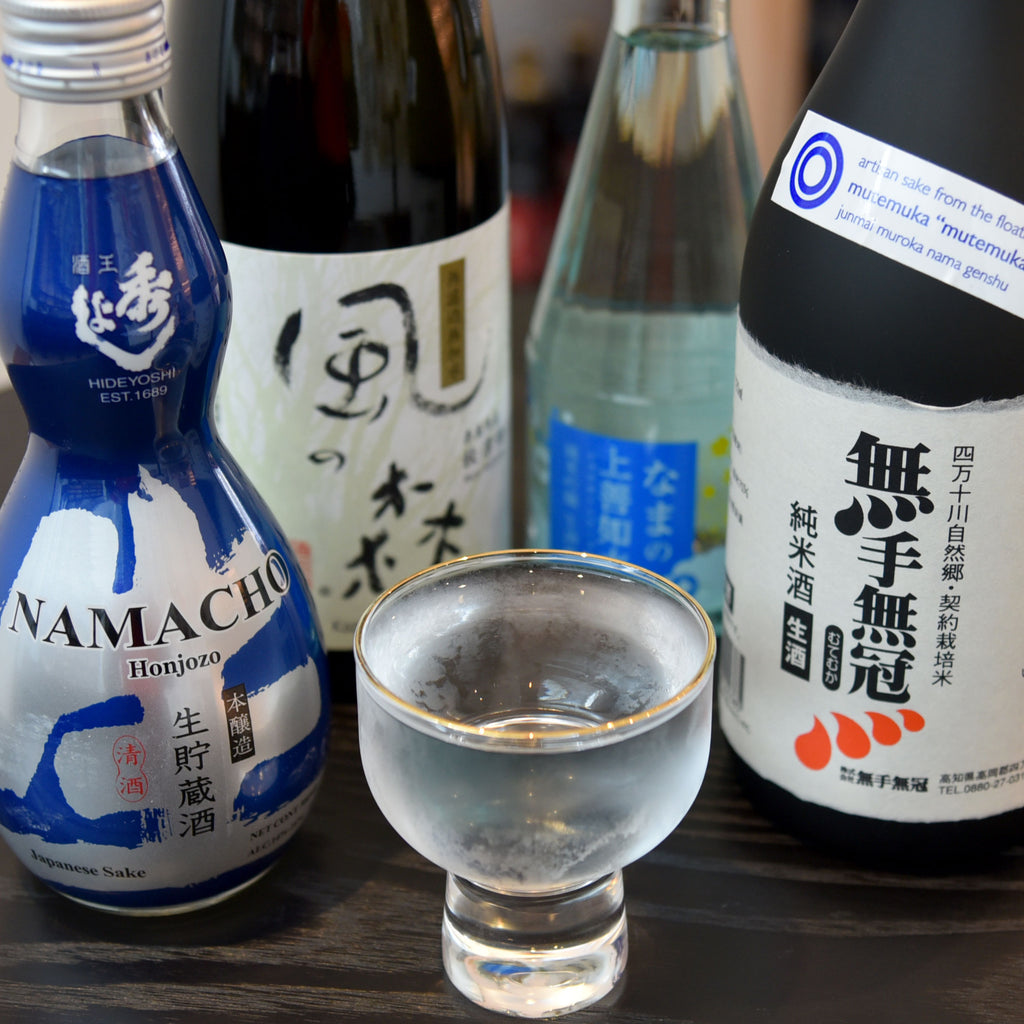 Sake Gumi is our monthly sake subscription service with 200 members throughout California. Join today!
Sake Gumi is our monthly sake subscription service with 200 members throughout California. Join today!
Nama sakes, or namazake, are unpasteurized sakes.
Before we dive deeper into namazakes, let's talk about how and why most sakes are pasteurized. Typically, sakes are pasteurized twice, once after pressing and a subsequent maturation period, and once before shipping. Pasteurization happens at a relatively low temperature at around 149˚F. This temperature is enough to kill the lactic acid bacteria called hiochi-kin, which can cause sake to spoil. If hiochi-kin proliferates in sake, it can taste excessively yeasty and syrupy, accompanied by white film that floats around in the sake - no thank you! To ensure that your namas do not spoil, keep your namas cool, away from the sun, and drink them as soon as possible!
So why do brewers release namas? Namas are enjoyed by people who want to try sake in their freshest state. Often times, namas are vibrant, bright, and have a fruity aroma. If they were pasteurized, some of these dynamic flavors would be smothered.
The world of namazake goes deep. There are several types of namas. Remember, regular sakes are pasteurized twice, once after pressing, and once before shipping.
Nama-zume Pasteurized right after pressing, and is stored at a low temperature for about six months, then skips pasteurization right before shipping.
Nama-chozo Skips pasteurization after pressing and stored at a low temperature for about six months, then pasteurized right before shipping.
Nama-nama or hon-nama Skips both pasteurizations
What are the differences? Nama-chozos and nama-zumes enjoy the best of both worlds because they are "half" pasteurized. They can retain some of the lively flavors of a nama-nama, but are also more shelf stable because they have been pasteurized once.
For this month's Sake Gumi, Level One members are getting a namachozo and a nama-nama, while Level Two members are getting two nama-namas. From March 26-29, we’ll be throwing NamaFest, a weekend of pouring limited namas at the bar, and tasting them alongside their pasteurized versions. Stay tuned!
Kanpai!
Yoko
Co-Founder + Sake Director
Umami Mart
LEVEL 1: Introductory Membership (Two 300ml bottles)
 Hideyoshi Namacho Honjozo
Hideyoshi Namacho Honjozo
Suzuki Shuzoten (Akita, Japan)
Seimaibuai: Menkoina 65%, SMV: +0.5
This one is for Kayoko, who says, “Honjozos are my jam.” This semi-dry sake is a namachozo, which means it skips the first pasteurization after pressing and is aged for at least six months, then pasteurized once before shipping out. This nama boasts a full aroma of banana cream pie, a gentle yeastiness in flavor, and finishes like a honjozo often does - dry and clean. Hints of yogurt makes this a great pairing with an herbed couscous salad. Enjoy chilled!
 Namazake no Jozen Junmai Ginjo
Namazake no Jozen Junmai Ginjo
Shirataki Sake Brewery (Niigata, Japan)
Seimaibuai: Koshi Ibuki 60%, SMV: +5
This nama-nama has a lively ginjo aroma, bursting with apple blossom, strawberry, and fresh grass. But it’s not one of those in-your-face bold namas - it enters smooth and pillowy, with hints of umami that reminds me of a raw tomato. I love the understated mineral finish that ultimately ends dry and refreshing. Try this pleasantly balanced sake chilled with an ultra nama (raw) pairing of ceviche or raw oysters!
LEVEL 2: Premium Membership (Two 720ml bottles)
 Kaze no Mori “Wind of the Woods” Junmai Muroka Nama Genshu
Kaze no Mori “Wind of the Woods” Junmai Muroka Nama Genshu
Yucho Shuzo (Nara, Japan)
Seimaibuai: Akitsuho 60%, SMV: +2.5
If you are a fan of a fresh, dry Pét-Nat, this is your sake! This light, and clean sake is so fresh it could be mistaken for a sparkling sake. Notice banana, cream, and koji on the nose. Unique flavors including asparagus, brie, and saffron will fill your palate in this lively brew. A light and clean finish leaves you wanting more. This sake shines with food - try chilled with grilled shrimp and vegetables or a juicy burger!
 Mutemuka Muroka Nama Genshu
Mutemuka Muroka Nama Genshu
Mutemuka Shuzo (Kochi, Japan)
Seimaibuai: Kaze Nurako + Hino-Hikari 65%, SMV: +5
I fell in love with sake all over again with this nama-nama! Weighty and complex, with tasting notes ranging from enoki, ginger, to imo shochu (for its long, earthy finish), there’s a lot to chew on here. Made using table rice (which yields a more robust flavor) and aged for half a year, I recommend this sake at room temperature or chilled. This lactic brew is a heavyweight when it comes to pairings. Try it with rich foods like fried chicken and bolognese.




Comments (1)
Hi!
I’d like to buy the last sale